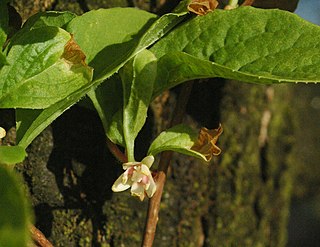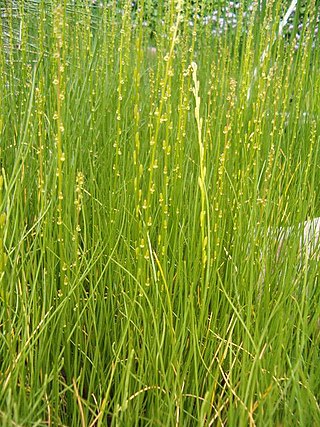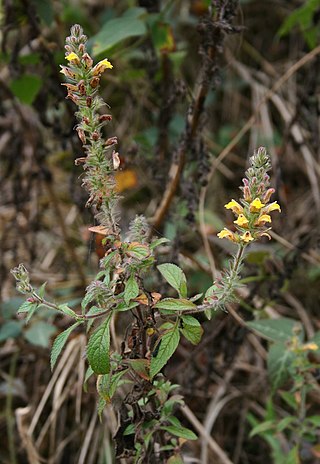
The Santalales are an order of flowering plants with a cosmopolitan distribution, but heavily concentrated in tropical and subtropical regions. It derives its name from its type genus Santalum (sandalwood). Mistletoe is the common name for a number of parasitic plants within the order.

Ceratophyllaceae is a cosmopolitan family of flowering plants including one living genus commonly found in ponds, marshes, and quiet streams in tropical and in temperate regions. It is the only extant family in the order Ceratophyllales. Species are commonly called coontails or hornworts, although hornwort is also used for unrelated plants of the division Anthocerotophyta.

The Zygophyllales are an order of dicotyledonous plants, comprising the following two families:

The Buxales are a small order of eudicot flowering plants, recognized by the APG IV system of 2016. The order includes the family Buxaceae; the families Didymelaceae and Haptanthaceae may also be recognized or may be included in the Buxaceae. Many members of the order are evergreen shrubs or trees, although some are herbaceous perennials. They have separate "male" (staminate) and "female" (carpellate) flowers, mostly on the same plant. Some species are of economic importance either for the wood they produce or as ornamental plants.

Linaceae is a family of flowering plants. The family is cosmopolitan, and includes about 250 species in 14 genera, classified into two subfamilies: the Linoideae and Hugonioideae. Leaves of the Linaceae are always simple; arrangement varies from alternate to opposite or whorled. The hermaphroditic, actinomorphic flowers are pentameric or, very rarely, tetrameric.

Schisandraceae is a family of flowering plants with 3 known genera and a total of 92 known species. Such a family has been recognized by most taxonomists, at least for the past several decades. Before that, the plants concerned were assigned to family Magnoliaceae and Illiciaceae.

Juncaginaceae is a family of flowering plants, recognized by most taxonomists for the past few decades. It is also known as the arrowgrass family. It includes 3 genera with a total of 34 known species.

Myrothamnus is a genus of flowering plants, consisting of two species of small xerophytic shrubs, in the southern parts of tropical Africa and in Madagascar. Myrothamnus is recognized as the only genus in the family Myrothamnaceae.

Lanaria is a monotypic genus of flowering plants containing a single species, Lanaria lanata, endemic to the southern coast of South Africa where it is associated with the fynbos belt. Lanaria lanata is commonly known as Cape edelweiss or lambtails. The genus is placed in the monotypic family Lanariaceae, a family only recently recognized by taxonomists. The APG IV system of 2016 does recognize this family.

Olacaceae is a family of flowering plants in the order Santalales. They are woody plants, native throughout the tropical regions of the world. As of July 2021, the circumscription of the family varies; some sources maintain a broad family, others split it into seven segregate families.

The Balanophoraceae are a subtropical to tropical family of obligate parasitic flowering plants, notable for their unusual development and formerly obscure affinities. In the broadest circumscription, the family consists of 16 genera. Alternatively, three genera may be split off into the segregate family Mystropetalaceae.

Lindenbergia is a genus of herbaceous plants in the order Lamiales and in the broomrape family Orobanchaceae. It is one of the few genera of the family which are not parasitic. It contains about 15 species found from northeast Africa across Asia to the Philippines, and is most abundant in India.

Oncotheca is a genus of tree endemic to New Caledonia. There are two species, Oncotheca balansae and Oncotheca humboldtiana.
Hondurodendron is a monotypic genus of tree endemic to Honduras. The only species in the genus, H. urceolatum, was discovered during 2004 and 2006 botanical surveys of plants in Parque Nacional El Cusuco in northwest Honduras. It was subsequently described in 2010 by Carmen Ulloa Ulloa, Daniel L. Nickrent, Caroline Whitefoord, and Daniel L. Kelly in the Annals of the Missouri Botanical Garden.

The Aptandraceae is a family of flowering plants in the sandalwood order Santalales that is recognized by some sources; others sink the family in Olacaceae. The members of the tropical plant family are parasitic on other plants, usually on the roots, and grow as trees, shrubs or woody lianas.
Aptandra is a genus of flowering plants. In the APG IV system, the genus is placed in the family Olacaceae. Other sources place it in the segregate family Aptandraceae.

Harmandia mekongensis is a species of flowering plants. It is the only species in the monotypic genus of Harmandia. In the APG IV system, the genus is placed in the family Olacaceae. Other sources place it in the segregate family Aptandraceae.
Ongokea is a genus of flowering plants, with one species Ongokea gore (Boleko). In the APG IV system, the genus is placed in the family Olacaceae. Other sources place it in the segregate family Aptandraceae.
Phanerodiscus is a genus of flowering plants. In the APG IV system, the genus is placed in the family Olacaceae. Other sources place it in the segregate family Aptandraceae.















